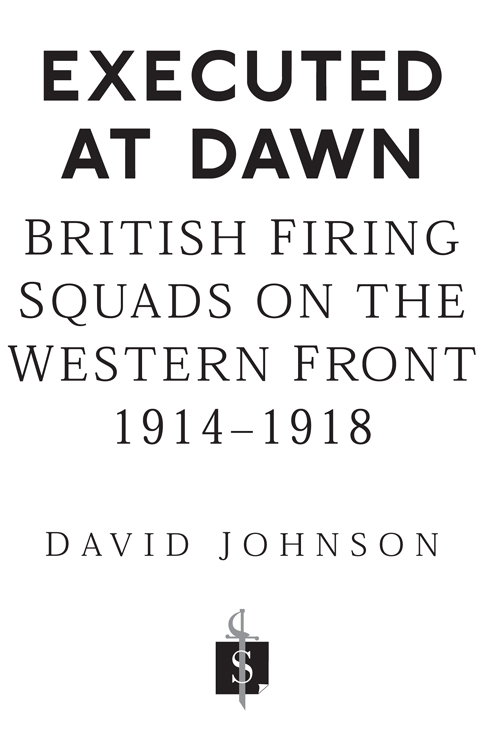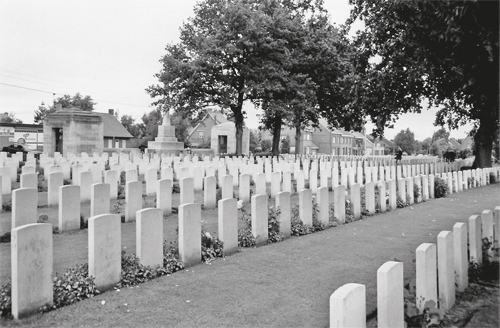Executed at Dawn
Authors: David Johnson



In memory of my mother
Winifred Johnson
11 January 1923â21 February 2014
For Those Shot For Cowardice
by A.R. (David) Lewis
Their voices echo down the years, demanding justice:
âIt's the noise, echoing, rebounding in the muddy trenches,
the shells continuous, shrieking, exploding in front and rear.'
I just wandered off, not knowing who, or what I was.
I'm not afraid to die, it's living in this hell,
that causes the problem â I start to shake â my mind goes dead.'
Then the finger pointing General âNo time for cowards,
court martial them. Stamp out this cancer'
Court martial's obligatory verdict guilty â punishment death.
Shell shock â trauma â just excuses for cowards.
Then the voices of the firing squads are also heard.
âThe poor devil was legless, his brain already dead.
His bowels running out of control. He called for his Mam,
as we tied him to the chair he talked to her'
âWhat are they doing to me, Mam?
I can't see you, Mam, they have covered my eyes.
Sorry Mam, I have messed myself. Help me, Mam.'
The executioners once more, âWhat a way to die,
his blood mingling with the filth in his trousers.
God forgive me my part in his death.'
And still the voices of the dead cry out.
âI'm not a coward â no blindfold for me,
I will look death full in the face â I am not guilty.
Shot as a coward, no pension for my wife.'
by A.R. (David) Lewis
At four in the morning, the shelling restarted.
Their shrieking and screaming, the only sound heard.
Stand to at five, advance at five thirty.
Knee deep in mud the soldiers waited,
to hear the whistle, the command to advance.
The young lad waited, head bowed, trembling.
Praying âPlease let's go â get out of this noise.'
Lips not moving, mind chanting âLet's go, let's go.'
Not afraid to charge forward to meet his fate,
the mud, the noise, the waiting caused his trauma.
The enemy now returned the shelling, increasing the bedlam,
adding the crunch and exploding noises.
The Soldiers cursed, and finished their smokes.
The young one now visibly shaking, not in control.
He dropped his rifle, turned and ran.
The regulation court martial just a formality.
The verdict âGuilty'. The sentence âDeath.'
Shell shock not mentioned, cowardice was.
The dishonoured young man to die at dawn.
His breakfast half a mug of rum, and five bullets to follow.
David Lewis is a prolific writer of prose and poetry (visit
www.proprose.co.uk
) who was born in 1919 and served with the Welsh Guards from 1938 to 1946, taking in both Dunkirk and the Normandy landings. David Lewis has kindly contributed three of his poems, which I am proud to include in this book. With his agreement, I have included two of these on the preceding pages and the third can be found at the end of the book. David has maintained a long-standing interest in the Shot at Dawn campaign, which he still considers to have some unfinished business in the sense that the complete story has not yet been told.
In 2009 I went on a tour of the Western Front, visiting Ypres, Passchendaele, the Messines Ridge, Ploegsteert, Arras, Vimy Ridge and the Somme, and I saw the execution post at Poperinghe. Reading about those places is one thing, but actually to be there is a truly powerful experience that I would recommend to anyone. Words cannot describe the emotional effect of visiting the immaculately maintained military cemeteries with their rows and rows of white headstones stretching off into the distance, or indeed attending the moving ceremony held at the Menin Gate in Ypres every evening. The headstones mark the final resting place of thousands of men killed in action, but in addition they also contain the graves of those who were executed, shot at dawn, by the British Army.

Poperinghe New Military Cemetery. As a major military centre just behind the lines that was relatively safe and close to Ypres, the town of Poperinghe (now Poperinge) was the location of numerous courts martial and executions. (Courtesy of Paul Kendall, author of
Aisne 1914
and
Bullecourt 1917
)
â â â
In the First World War, 302 British and Commonwealth soldiers, representing about one in ten of those condemned, were executed for military offences committed whilst on active service on the Western Front (Babington, 2002) and we know the names and the circumstances of those shot thanks to the research of Julian Putkowski and Julian Sykes in
Shot at Dawn
, first published in 1989, and that of Cathryn Corns and John Hughes-Wilson in
Blindfold and Alone
in 2001.
The books written so far have tended to focus on the controversy surrounding their cases and the court martial processes involved, and therefore it is not my intention in this book to go over that ground again, except where it is necessary for contextual purposes. My focus is on military executions post-confirmation of the sentence, and it seems appropriate therefore that the book should consider the issues of abolition and pardons. In doing this the book will examine the executions from the perspective of the members of the firing squad, the officers in charge, the army chaplains, the medical officers and the others who would have been present apart from those who took part, because, unsurprisingly, much less is known about them.
Soldiers have always had a natural reticence to speak to their families about the fighting that they have been involved in and the horrors that they have witnessed. If speaking about killing the enemy is so difficult, then how much harder it would have been to speak about witnessing or taking part in the execution of one of your own, perhaps even someone that you had known or had enlisted with in one of the so-called âpals battalions'. It is almost impossible to imagine what it must have been like living with those images in your mind â particularly in smaller communities where relatives and friends of the deceased may have frequented the same shops, factories and public houses as you, and as a result may have asked you awkward questions in an effort to find out how a loved one had died.
Unfortunately many of those who took part in British military executions were themselves killed in later combat and therefore the story of their involvement may be thought to have died with them. However, it has been possible to discover some of their names and some of their stories. Investigating events that took place a century ago means that there are now no opportunities for primary research, as even those who fought and survived are now all dead, and the opportunity to speak to them has long passed. This book, therefore, relies on secondary research drawing on what has already been published, together with personal and regimental diaries and letters, where these exist. It is through that research that the book will seek to explore and tell the stories of how those involved were selected, how they were treated before, during, and after the executions, and why there appears to have been so many procedural variations in the way that the executions were conducted on the Western Front.
I believe that all research must have a question at its heart, and it is this last point that fulfils that role. The British Army was at the time of the First World War, as it is now, a highly regulated organisation, with the smallest detail of army life set out in the Army Acts, military law and the King's Regulations, and so it is not unreasonable to assume that executions would have been regulated and consistent, in accordance with a form of established âstandard operating procedure', to ensure that they were conducted as humanely as possible.
In turn, it would not be unreasonable to ask why a century later this might still be of interest to anyone. The truthful response is that although this book will not change anything, I believe it is a worthwhile subject to explore because it will add to the knowledge and understanding of yet another aspect of the First World War. Executions are an aspect of the First World War that still remains a source of discomfort to many, and yet they are a part of the story of that conflict and continue to cast their long shadow over a century later.
The book will also discuss the related issues of the abolition of the death penalty in the British Army and the campaign to secure pardons for those executed.
In addition, there is a link between this book and my previous one (
One Soldier and Hitler, 1918
, hardback/
The Man Who Didn't Shoot Hitler
, paperback), which is a biography of Private Henry Tandey, VC, DCM, MM, the most decorated British private soldier to survive the First World War. In that book I wrote about the case of Drummer Frederick Rose of the 2nd Battalion of the Yorkshire Regiment (later to be known as the Green Howards) who was executed for desertion.
Drummer Rose would almost certainly have been known to Henry, as they served in the same battalion and would have headed off to Flanders together in August 1914. However, in December 1914 Rose had deserted his battalion and remained absent until December 1916. He was sentenced to death and executed by firing squad on 4 March 1917, by which time Henry was hospitalised in Britain for treatment to a wound received at the Battle of the Somme. Therefore, he was spared having to witness, or even be a member of, the firing squad. But it made me realise how close Henry had come to being part of one of these executions. As Henry did not appear to have kept a diary, sent letters to family or friends, or talked to them about his experiences, it is impossible to know his views on the death penalty or of taking part in a firing squad, but it set me thinking, and the result is this book.
